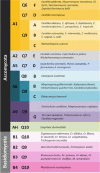Phylogenetic relationships matter: antifungal susceptibility among clinically relevant yeasts
- PMID: 24366735
- PMCID: PMC3957855
- DOI: 10.1128/AAC.01799-13
Phylogenetic relationships matter: antifungal susceptibility among clinically relevant yeasts
Abstract
The objective of this study was 2-fold: to evaluate whether phylogenetically closely related yeasts share common antifungal susceptibility profiles (ASPs) and whether these ASPs can be predicted from phylogeny. To address this question, 9,627 yeast strains were collected and tested for their antifungal susceptibility. Isolates were reidentified by considering recent changes in taxonomy and nomenclature. A phylogenetic (PHYLO) code based on the results of multilocus sequence analyses (large-subunit rRNA, small-subunit rRNA, translation elongation factor 1α, RNA polymerase II subunits 1 and 2) and the classification of the cellular neutral sugar composition of coenzyme Q and 18S ribosomal DNA was created to group related yeasts into PHYLO groups. The ASPs were determined for fluconazole, itraconazole, and voriconazole in each PHYLO group. The majority (95%) of the yeast strains were Ascomycetes. After reclassification, a total of 23 genera and 54 species were identified, resulting in an increase of 64% of genera and a decrease of 5% of species compared with the initial identification. These taxa were assigned to 17 distinct PHYLO groups (Ascomycota, n=13; Basidiomycota, n=4). ASPs for azoles were similar among members of the same PHYLO group and different between the various PHYLO groups. Yeast phylogeny may be an additional tool to significantly enhance the assessment of MIC values and to predict antifungal susceptibility, thereby more rapidly initiating appropriate patient management.
Figures
References
-
- Hennebert GL, Weresub LK. 1977. Terms for states and forms of fungi, their names and types. Mycotaxon 6:207–211
-
- Saccardo PA. 1880. Conspectus generum fungorum Italiae inferiorum. Michelia 2:1–38
-
- Gams W. 1995. How natural should anamorph genera be? Can. J. Bot. 73:747–753. 10.1139/b95-318 - DOI
-
- McNeill JM, Barrie FR, Buck WR, Demoulin V, Greuter W, Hawksworth DL, Herendeen PS, Knapp S, Marhold K, Prado J, Pru'homme van Reine WF, Smith GE, Wiersema JH, Turland N. (ed). 2012. International Code of Nomenclature for Algae, Fungi, and Plants (Melbourne Code) adopted by the Eighteenth International Botanical Congress, Melbourne, Australia, July 2011. A. R. G. Gantner Verlag, Ruggell, Liechtenstein
MeSH terms
Substances
LinkOut - more resources
Full Text Sources
Other Literature Sources
Molecular Biology Databases


